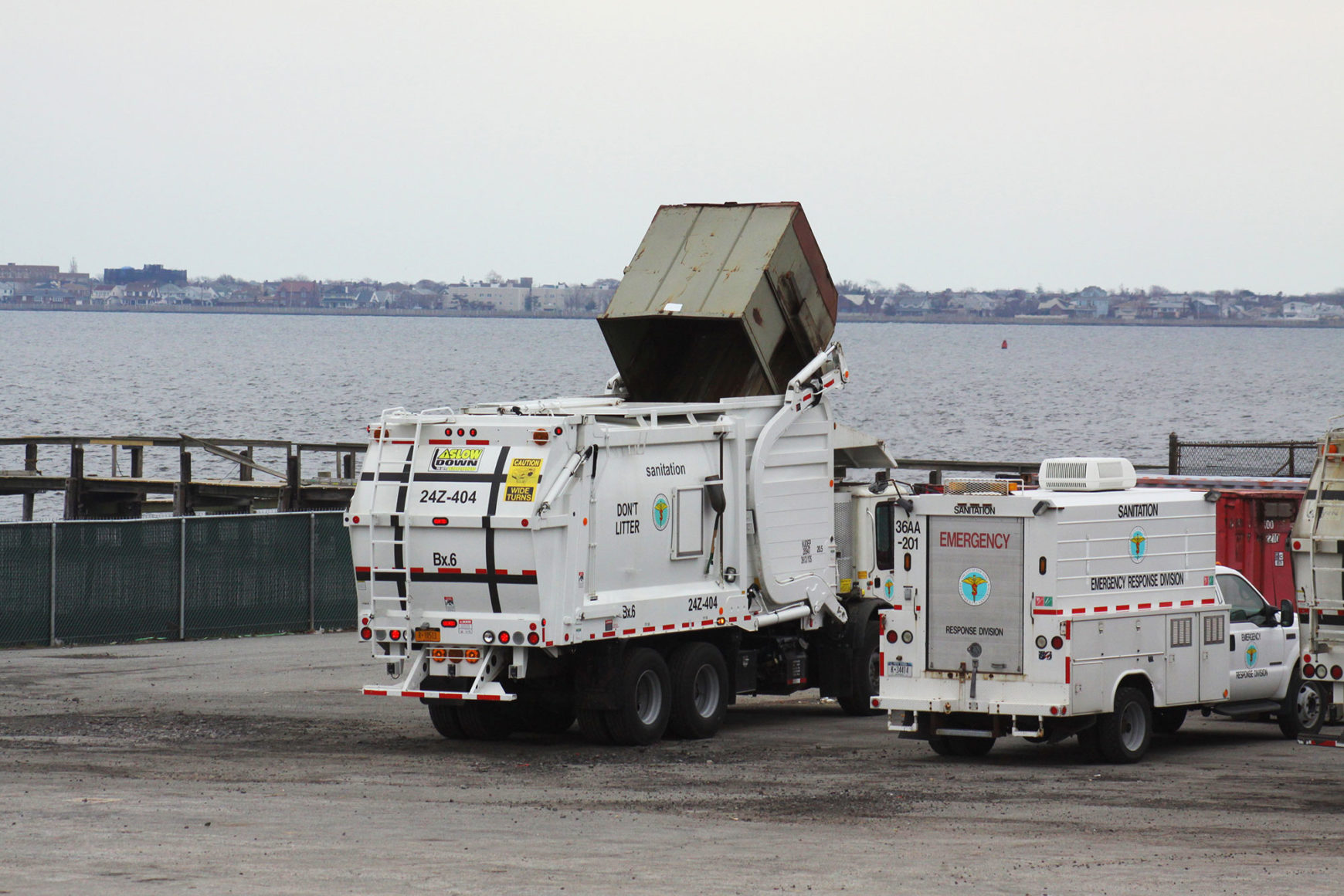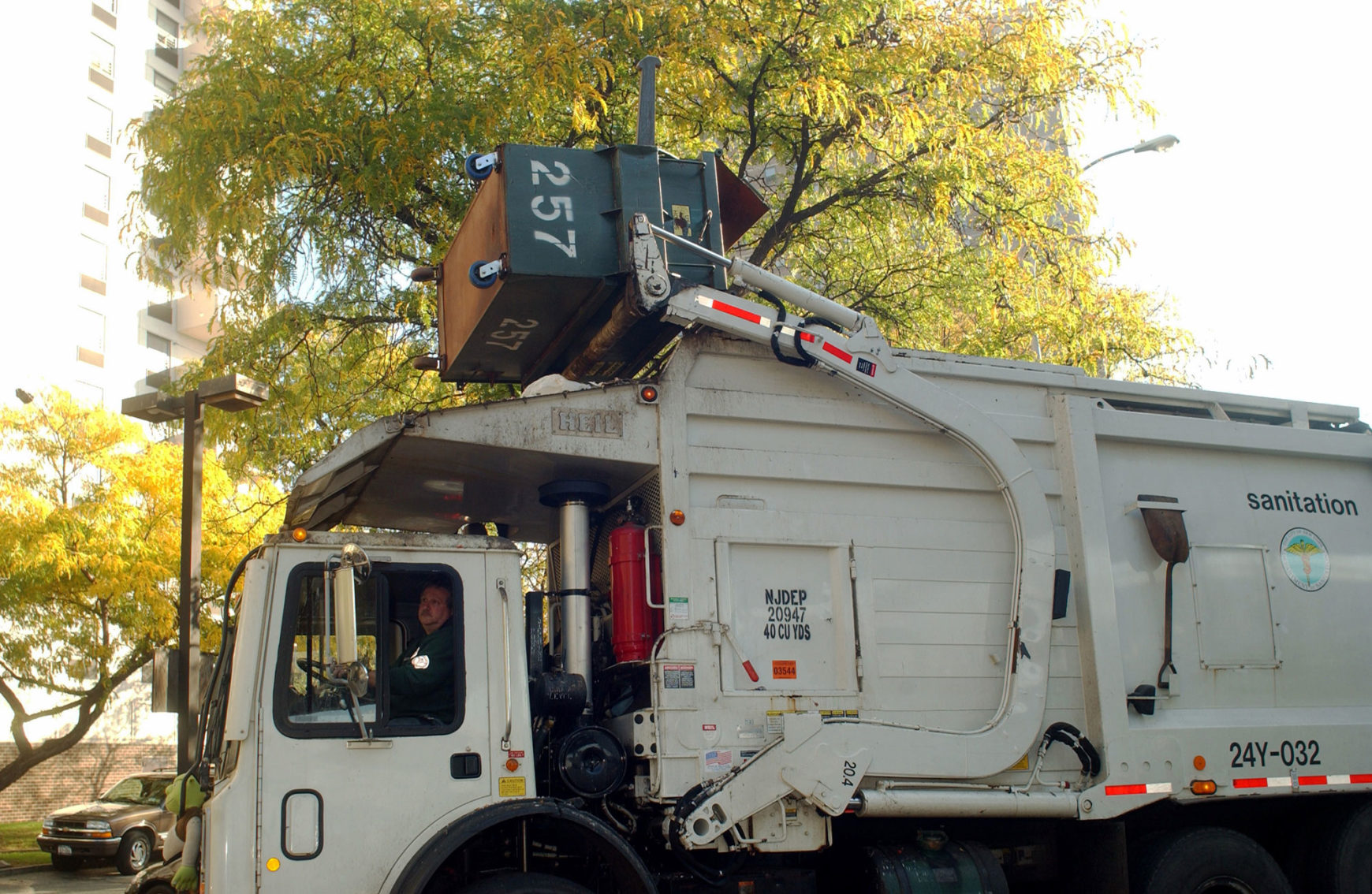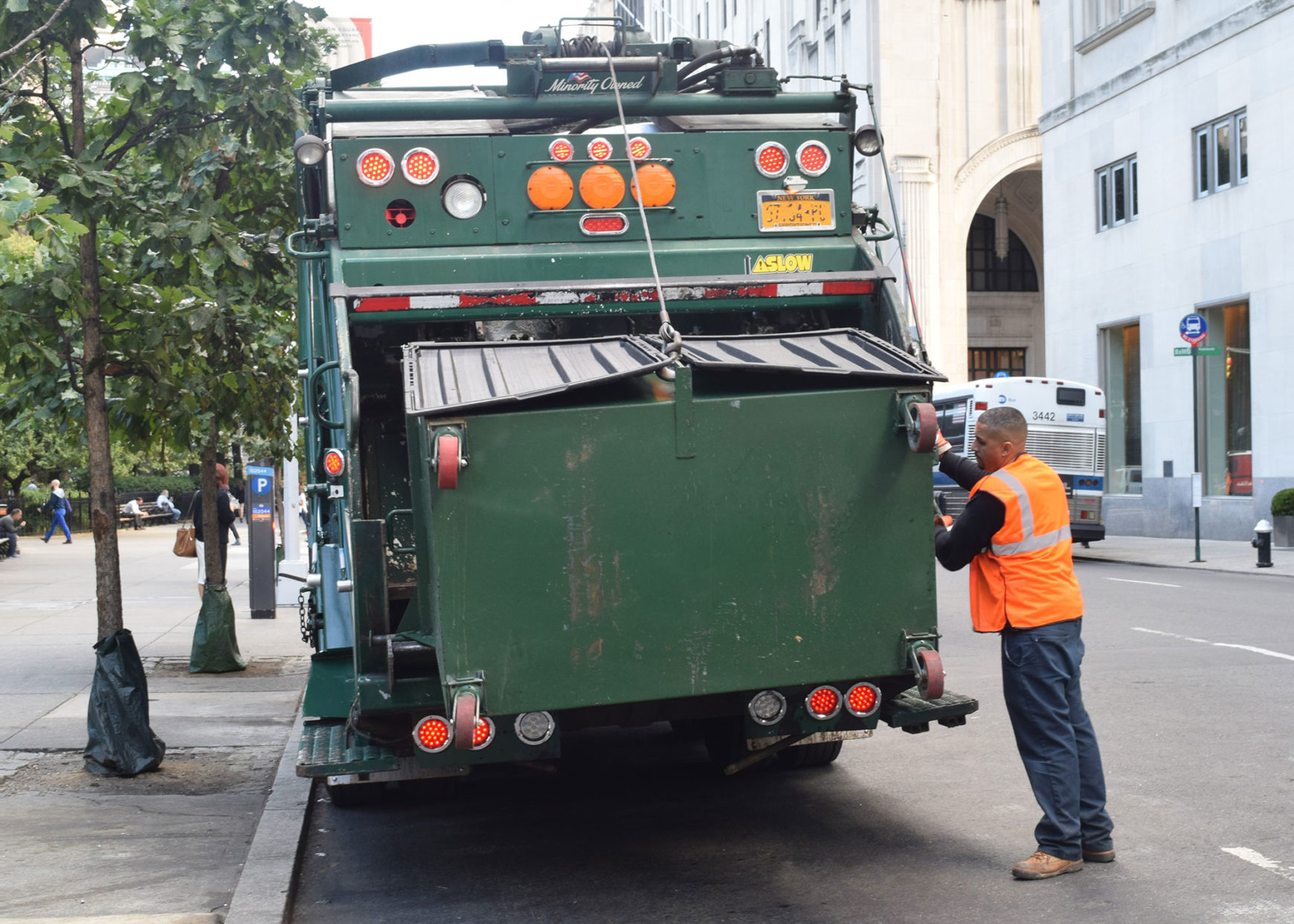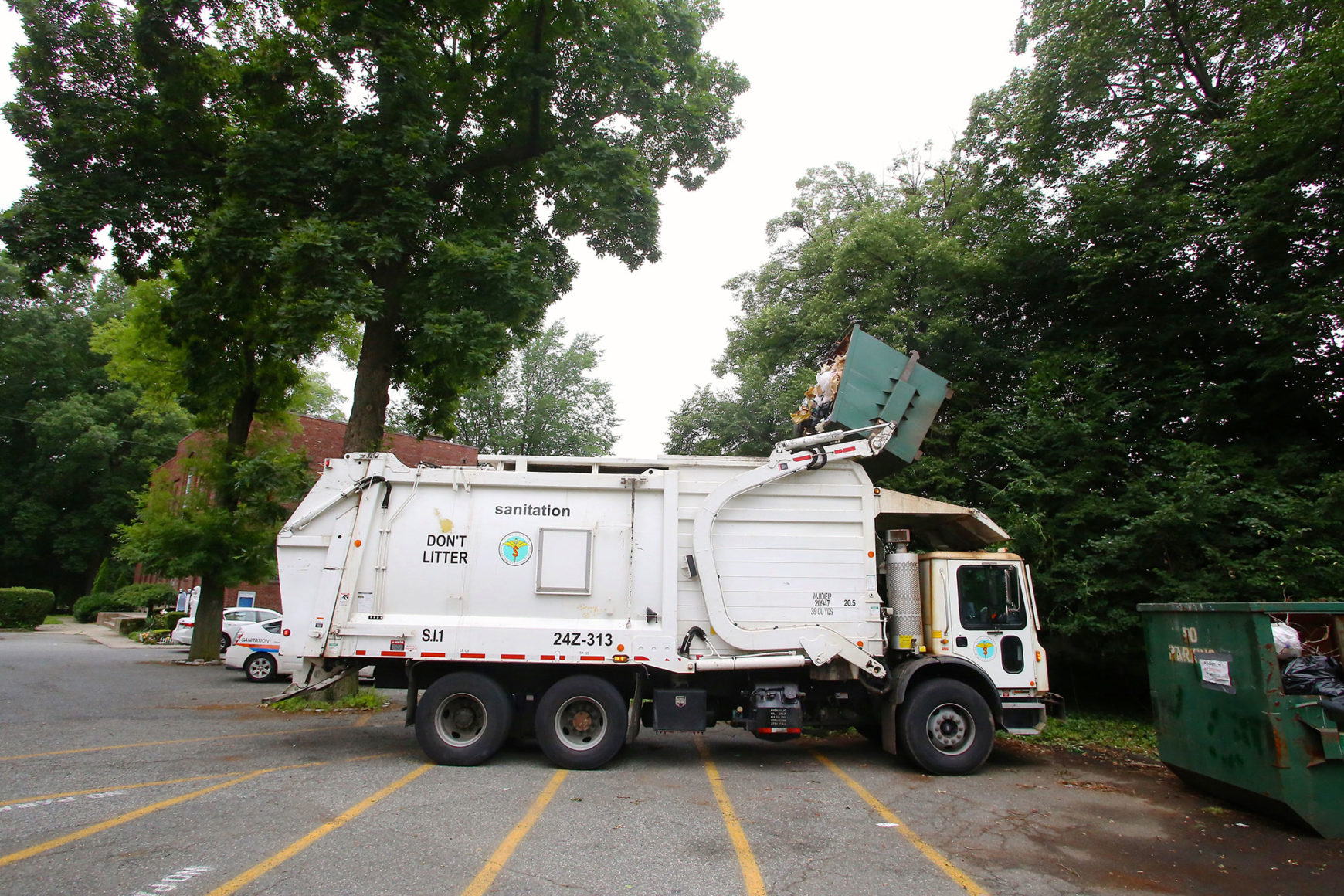Background
Over the centuries and decades, the logistics of collection and transport have changed, from no containers at all to barrels and metal cans to plastic bags and compacting containers. Collection forces changed from all private to (almost) all public to the current system of public collection for residential, institutional and litter bin wastes and private collection of commercial discards.
Because the New York City street grid was laid out without alleys, all material must enter and exit the public face of the building and cross the public sidewalk to get between the building and the street. Since discards are only staged at the curb while they are awaiting pickup, city planners have traditionally excluded them from street design.1 But the way they are set out on and picked up from the city’s sidewalks and streets has a significant impact on the urban quality of life and on residents’ and businesses’ ability to reduce the volume of waste exported to landfills and waste-to-energy facilities. ← Public space litter bins are described, but there is no discussion of waste flows from buildings. New York City Department of Transportation, “Street Design Manual” (12/2015): 183, link.
Door-to-Door and Aggregated (Shared) Collection
Collection from buildings can be divided into two categories: door-to-door, in which the material from each building is set out in front of it, and aggregated, in which material from multiple buildings is consolidated at a single location. In NYC, nearly all buildings have door-to-door collection, and aggregated collection is typically limited to large developments of multiple buildings under a single management team.
Environmental Impacts
In addition to the obvious local impacts of discards at the curb are the impacts of truck collection on the city as a whole. The trucks that stop in front of every building in the city multiple times a week (or day), idling and compacting, travel about 50 million miles a year. Compactor trucks average 3 mpg on their routes. Collection burns upwards of 10 million gal. of diesel fuel a year, releasing tons of greenhouse gases and other harmful emissions and causing significant levels of congestion. Collection trucks are also a major source of noise complaints. ← (Prior to instituting separate collection of organics) the DSNY collection fleet traveled about 25 million miles a year, while the private collection fleet traveled about 23 million miles. DSNY, “2012 Annual Report on Alternative Fuel Vehicle Programs Pursuant to Local Law 38 of 2005,” 1. link; DSNY/BIC, “Private Carting Study, Executive Summary” (8/17/2016): 6. link; New West Technologies LLC, “Multi-Fleet Demonstration of Hydraulic Regenerative Braking Technology in Refuse Truck Applications,” final report prepared for NYSERDA and NASEO (12/2011): 19; New Yorkers file more official complaints about garbage trucks than any other source of noise. In 2012, 5% of all 311 calls concerned garbage trucks. John Metcalfe, “Yo, I’m Trying to Sleep Here! New York’s Wonderful Map of Noise,” Citylab (4/15/2013). link.

Rear load truck collecting waste door-to-door

Building staff consolidating waste at a shared collection point
Safety Issues
Setting out and collecting wastes and recyclables is one of the most dangerous occupational activities. Sanitation workers, according to the US Bureau of Labor Statistics, are three times as likely to die on the job as are police officers, and 15 times as likely as firefighters. Garbage trucks in NYC kill four times as many pedestrians as cabs do: 24 people per 100 million miles. And handling waste is one of the greatest sources of occupational injury for building maintenance staff. ← The fatality rate for waste collection workers is 38.8/100,000; police, 13.5; firefighters, 2.5. U.S. Bureau of Labor Statistics, National Census of Fatal Occupational Injuries, 2015 (12/16/2016), link; Fact Sheet, Police Officers (8/2016), link; Firefighter Factsheet (7/2013), link; Charles Komanoff and members of Right of Way, “Killed by Automobile,” 3/1999 (cited by James Rutenberg, NY Daily News, 4/5/1999). Nationally, the most overall traffic fatalities caused by trucks are caused by dump trucks (5.96 fatalities per 100 million miles), while garbage trucks are second overall (5.12/100m). Jonathan Rosenfeld, “Commercial Truck Fatality Statistics,” 5/1/2013, link; Cleaning staff, together with police officers, nursing aides and tractor-trailer drivers, account for most workers’ compensation claims (20% of all claims), and strains and sprains from material handling and lifting are the leading cause of injury for all workers (30% of all cases). “Workers’ Compensation: Five Most Common Injuries,” National Law Review (11/3/2016), link.
Balancing Diversion from Disposal and Collection and Transport Impacts
The design of the collection process has a direct effect on the volume of material diverted from landfills. For example, a single-stream recycling operation (metal/glass/plastic collected in the same container and truck compartment as paper and cardboard) reduces the number of separate truck trips and truck miles logged. However, while it is possible to sort such a commingled stream after collection, cross-contamination between material types can affect their ability to be processed and marketed, hence their ability to be diverted from disposal. On the flip side, more source-separated fractions will increase truck trips and truck miles traveled. Trucks could collect less frequently if investments were made in storage space or volume-reducing equipment. (See Chapter 2 for Best Practice Strategies for Building Design.)

Loading area with truck making deliveries adjacent to compactor container
DSNY Zero Waste Initiatives Concerning Collection
The city is engaged in a number of initiatives that should help reduce both the amount of material disposed in landfills and the impacts of collection. DSNY is considering implementing a save-as-you-throw (SAYT) system, which would provide an economic incentive for reduction and recycling. It is also developing plans for zoned commercial collection, which should minimize truck miles traveled while producing other desirable effects. And DSNY is expanding opportunities for drop-off collections of food scraps, textiles, e-waste and hazardous waste, along with special bins for voluntary collections of textiles and e-waste from multifamily buildings. ← See DSNY/BIC, “Private Carting Study” (8/17/2016), link.


Deliveries/Reverse Logistics
The inbound flow of deliveries is mirrored by the outbound flow of building discards. However, because collecting discards is considered a waste management problem rather than a distribution logistics issue, transportation planners typically do not include it in models for sustainable “last mile” urban freight transport. Viewed from a zero waste perspective, all these materials should be managed as freight.
Rules/Agency Roles
Because collection takes place at the interface between private property and the street, collection strategies fall under a number of overlapping jurisdictions. DSNY decides what can be set out on the curb—and where and when—and determines the schedule for street cleaning. Meanwhile, the Department of Transportation decides what can be stored or driven on the streets and sidewalks and where cars can park. The Zoning Resolution determines where loading docks and curb cuts are permitted and, along with the building code, what kind of waste storage space is required.
Rules vary depending on zoning, land use and particular neighborhood features. DSNY requirements differ from what a private carter may specify, so options for commercial properties are not necessarily the same as those for residential buildings. (See NYC Rules for Setout Exterior Storage infographics, above, and Agency Roles, below, for an overview.) Collection strategies will depend on the characteristics of the storage space available within the building property. (See Chapter 2 for rules.)

NYC DOT Street Design Manual, 2015
Recommendations
Given the specific circumstances of each building and public space, buildings should use the collection strategy that allows for the most efficient transfer from storage area to truck. (For DSNY options, see Chapter 2 on DSNY rules.) On the street, containers reduce litter, drips, odors and rats, and other nuisances associated with piles of bags. They also allow for automated collection, which can reduce worker injuries and the time and costs of collection, as well as collection frequency. ← Manual collection crews lift on average of 6 tons per worker per shift, leading to increases in musculoskeletal injuries. Pamela McCauley Bush et al., “Ergonomic & Environmental Study of Solid Waste Collection” final report, Environmental Research and Education Foundation (2012): 3, link.
Containers, already required for organics, are also suitable for collecting textiles and e-waste. Therefore, when possible, use containers, preferably with compaction. For businesses, small wheeled bins could be the default solution when larger containers are not practicable. (See BPS 2.04 for a discussion of how to plan for containers inside buildings and in the streetscape directly in front of individual buildings.) When there is no space inside existing buildings or on side-walks, it may be possible to share storage with neighboring properties or aggregate material at a neighborhood scale with a centralized facility. The best practice strategies discussed in this chapter focus on using the collective resources of a block or neighborhood to introduce containerization, improve collection efficiency and support zero waste initiatives. Master plans for new and existing large-scale developments should also consider aggregated collection. ← “The Centers for Disease Control and Prevention considers plastic bags inappropriate for outside overnight garbage storage because rats and other animals can and will chew through the bags (CDC, 2006). The consistent availability of curbside food waste trains rats to return to these locations and makes eradication difficult, as indicated in our findings of greater rat activity near restaurants.” Sarah Johnson et al., NYC DOHMH, “Characteristics of the Built Environment and the Presence of the Norway Rat in New York City: Results From a Neighborhood Rat Surveillance Program, 2008–2010,” in Journal of Environmental Health (June 2016): 27. Recognizing the role of bagged waste in rat infestations, the city is proposing to reduce time bags can sit on the curb. “The (rat mitigation) plan proposes a local law that requires buildings containing more than ten units within the Mitigation Zones to curb garbage after 4am the day of trash collection, greatly reducing the availability of rats’ food source.” The City of New York, “De Blasio Administration Announces $32 Million Neighborhood Rat Reduction Plan,” (6/12/2017), link.

Truck Collection Typologies
The sort of container chosen for collection will depend on the volume of waste, the accessibility and size of the storage area, and vehicle-access options. Truck collection typologies are generally the same for door-to-door and aggregated collections except that aggregated collection also involves moving material between individual buildings and the shared collection point.

Typology 1: Bags on Street
The dominant strategy for door-to-door collection in NYC is to bring bags from a storage area and pile them on the curb.

Bags set out on the street in Downtown Brooklyn
Advantages
- There’s no need for elevator or ramped access between the basement (or other storage areas) and the street because bags can be carried upstairs.
- Flexibility: Storage space doesn’t have to accommodate the spe-cific dimensions of containers, and bags can be piled to fill the available space.
- The absence of containers means that there is no maintenance, storage or inside return required after pickup.
- Bags can be carried between parked cars to a truck. ← See Bush et al., “Ergonomic & Environmental Study,” 4.
Disadvantages
- When set directly on the curb, bags can be torn open by rats and other pests. (For this and other reasons, organics are not collected in bags.) ← NYC DHHMH researchers suggested “hard-sided containers could help reduce or prevent rat infestation” and initiated a pilot including containerization to target rat reservoirs. See Johnson et al., “Characteristics of the Built Environment,” 28;“Almost half [of overexertion injuries and lost work days involved lifting, throwing, or carrying garbage containers, whereas 4% of overexertion injuries were caused by pushing or pulling waste containers.” Bush et al., “Ergonomic & Environmental Study,” 4.]
- Unsightly piles of bags impinge on public space and often leave litter, liquids and odors on the sidewalk after collection.
- Piling bags on the curb and carrying and throwing them from curb to truck is time-intensive and physically demanding; it can also be a significant source of injuries such as strains and sprains.
- Bags can neither weigh more than 50 lbs, per OSHA rules, nor be used with automated or semi-automated collection trucks. (See Rules and Standards in Chapter 2.)
- Bags are breakable, thus potentially dangerous to building staff and sanitation crews when sharp or toxic materials are present.
Typology 2: Wheeled Bins on Street
Wheeled bins are heavy-duty plastic carts with two to four wheels. They are compact and easy to maneuver yet have limited capacity—up to 96 gal. or 0.25 cu yd. In NYC, wheeled bins are used for organics collection, for storage and setout from smaller buildings and in low-density neighborhoods where buildings have ample storage and curb access relative to the volume of waste generated.
Although they are compatible with automated collection, DSNY currently empties bins manually into trucks. For DSNY collection, bins typically lack wheels and must be 44 gal. for trash and 32 gal. for recyclables. Wheeled organics bins provided by DSNY are 13, 21 or 32 gal., to allow for manual lifting.

Bins for trash, recycling and organics are emptied manually into rear-load trucks
Advantages
- Waste is protected from rats and pests. ← Use of wheeled bins with automated collection may require changes in union or labor agreements, truck retrofits, or require operational changes by building management;Bags need to be manually lifted each time they are moved from point of origin to temporary storage location to setout at the curb. By containing multiple bags, bins reduce the number of lifts required.
- Material is protected from rain and snow.
- Workers are protected from dangerous contents and unsafe load weights.
- Wheeled bins, which are compatible with automated and semi-automated collection trucks, can be heavier than the weight safe for manual lifting.
- Bins can be tracked, allowing for easy implementation of unit pricing/SAYT.
- Bags are optional; materials can be placed directly in the bin.
- Bins can reduce waste handling.
Disadvantages
- The storage area must accommodate bin maneuvering and have a clear path by elevator/ramp to the curb.
- At the curb, adequate space is needed to roll the bin to the truck.
- Wheeled bins must be returned to the storage area.
- Bins require cleaning and can be damaged.
Typology 3: 1-8 cu yd Containers
Front-end load (FEL) or rear-end load (REL) containers are steel or plastic carts with lids. Containers under 3 cu yd are wheeled to the curb; larger containers are emptied directly from the loading dock or courtyard where they are stored. Containers can be submerged underground and emptied into trucks with cranes.
- FEL with wheels and without wheels emptied by DSNY, REL emptied by commercial hauler
Advantages
- See wheeled bin advantages in typology 2.
- Increased capacity can reduce collection frequency relative to that for wheeled bins and bags.
- Metal containers can be fitted with a compactor to increase capacity.
- The containers can be connected directly to chutes.
Disadvantages
- See wheeled bin disadvantages.
- Container loading is more involved and truck clearances are required.
- Collection can be noisy.
Typology 4: 20-40 cu yd (RoRo) Containers
The 20–40 cu yd containers are loaded directly from the compactor yard or loading dock onto the flatbed of the collection truck. Containers can be open-top (for construction debris or recyclables) or fully enclosed and fitted with a self-contained or separate compactor. Each container collection requires a dedicated trip in which the container is loaded onto the truck, driven to the transfer facility, dumped and returned. Containers are used by large commercial, mixed-use and institutional buildings and also for aggregated collection. ← The need for a round trip with an empty container could be avoided—and truck miles effectively halved—if a system similar to those used for railcars or port-truck chassis were developed, in which the containers are centrally owned and provided by the system operator as part of collection service. See Benjamin Miller, “Managing New York’s Municipal Solid Waste to Support the City’s Goal of Reducing Greenhouse Gases by 80% by 2050,” white paper for the New York League of Conservation Voters (7/13/17): 14. Refer to the waste calculator to determine whether a building will generate enough waste to make a container the optimal option.

Roll on truck pulling a compactor from a loading dock
Advantages
- Compactor containers have higher capacity than a rear-load compactor truck.
- Compactor containers require the fewest truck miles and labor hours per ton.
- Can be connected directly to chutes.
- Can incorporate compaction.
- Self-contained compactors are sealed.
- Compactor containers are difficult to overload or close improperly. ← Rae Zimmerman et al., “Expanding the Use of Roll-On, Roll-Off Trash Compactor Technology to Reduce Rodent Infestations in New York City: NYC Private Multiple-Dwelling Deployment Assessment,” NYU Wagner School of Public Service Institute for Civil Infrastructure Systems (6/2009): 4, link.
Disadvantages
- See 1–8-cu yd container disadvantages in typology 3.
- Equipment is expensive and requires some training to operate and a maintenance routine; DSNY also requires insurance.
- A curb cut is needed for truck access.
- A truck-accessible storage area with sufficient head height and space for truck maneuvering is required.
- Waste aggregated while the container is off-site for collection needs to be stored.
- If the containers are not self-contained or if waste accumulates too slowly, containers may be emptied when only partially full for odor-control reasons, reducing efficiency.
- Collection can be noisy.

Share this page Next Section: Collection & Urban Design Best Practice Strategies →



